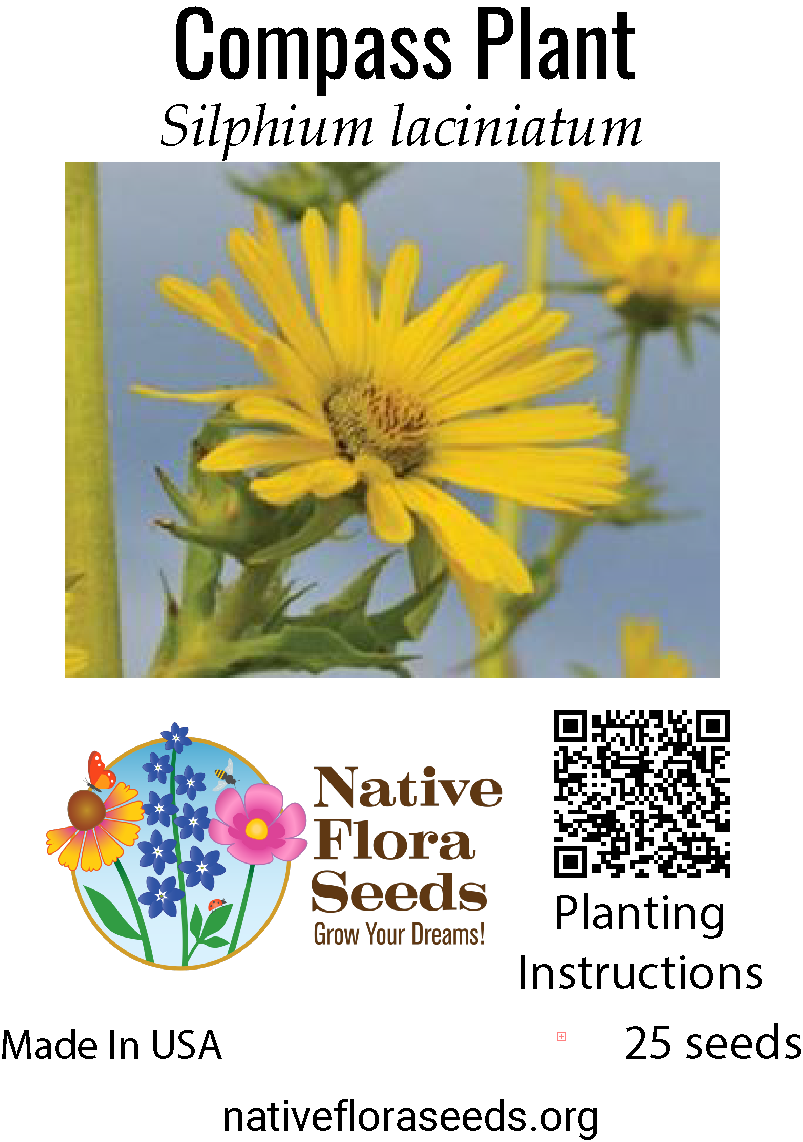Silphium laciniatum (compass plant) is a native perennial that thrives in open meadows and prairies and is known for its tall, striking flowers and unique north-south oriented leaves. Here are the planting instructions for sowing seeds both outdoors and indoors, as well as care tips:
Planting Outdoors (Fall & Spring)
Site Selection
Choose a full sun location, as Silphium laciniatum requires 6–8 hours of direct sunlight per day to grow optimally.
The plant prefers well-drained soil and can tolerate a range of soil types, including sandy, loamy, or clay soil, as long as it is not waterlogged.
Moderate to low moisture is ideal once the plant is established, but ensure the soil doesn't dry out completely during the initial stages of growth.
Consider planting in meadows, prairies, roadsides, or naturalized gardens to mimic its natural habitat.
Soil Preparation
Prepare the soil by removing any weeds or debris.
Silphium laciniatum prefers deep, fertile, well-drained soil. You can amend your soil with organic matter (e.g., compost) to improve fertility and drainage.
This plant thrives in soil that is slightly acidic to neutral (pH 6.0-7.5).
Planting Depth
Surface sowing is recommended as the seeds need light for germination. Sprinkle the seeds evenly over the soil surface.
Lightly press them into the soil or cover them with a thin layer of fine soil or sand. Do not bury them deeply as they need light exposure.
Watering
Keep the soil moist during germination, but not waterlogged.
After the seeds have germinated and the plants are established, Silphium laciniatum is drought-tolerant and prefers moderate watering, especially in dry conditions.
Avoid overwatering, as this can lead to root rot.
Stratification & Scarification
Stratification: Silphium laciniatum seeds require cold stratification to break dormancy. For fall sowing, the seeds will naturally undergo stratification over the winter.
If sowing in spring, you will need to cold-stratify the seeds by placing them in a moist paper towel or sand inside a plastic bag and refrigerating them for 30–60 days before planting.
Scarification is not necessary for Silphium laciniatum seeds.
Timing
Fall Sowing: Plant seeds in late fall after the first frost. The cold winter conditions will stratify the seeds and they will germinate in the spring.
Spring Sowing: If sowing in spring, ensure the seeds have been stratified for 30–60 days in the refrigerator and sow them after the last frost, when the soil temperature is consistently warm.
Maintenance
Once the seedlings emerge, thin them to 12–24 inches apart to ensure proper air circulation and allow the plants to grow to their full size.
Weed control is essential during the early stages of growth, especially as Silphium laciniatum establishes itself.
Mulch around the plants to help retain moisture and suppress weeds, but avoid covering the base of the plant directly.
Deadhead flowers after bloom to prevent excessive self-seeding, if you prefer to control their spread.
Prune back any dead or damaged stems in late winter or early spring to promote fresh growth.
Starting Seeds Indoors (Spring for Later Transplanting)
Planting Containers
Start seeds indoors 6–8 weeks before the last expected frost in your area.
Use seed trays or individual pots with good drainage.
Fill the containers with a well-draining seed-starting mix.
Soil & Planting
Sprinkle the seeds on the surface of the soil and press them gently into the mix. Cover lightly with a thin layer of soil or sand.
Keep the soil moist, but not waterlogged, during the germination process.
Stratification
For indoor sowing, cold-stratify the seeds by placing them in a moist paper towel or sand in the refrigerator for 30–60 days before sowing.
After stratification, sow the seeds indoors and provide proper care for germination.
Germination
Germination usually occurs within 14–30 days at temperatures of 65–75°F (18–24°C).
Keep the seedlings in bright, indirect light or use a grow light. Avoid direct sunlight, as this can stress the seedlings.
Transplanting Outdoors
Once the seedlings have several sets of true leaves and the threat of frost has passed, harden them off by gradually introducing them to outdoor conditions over 7–10 days.
After hardening off, transplant the seedlings into the prepared outdoor bed, spacing them 12–24 inches apart.
Invasiveness
Silphium laciniatum is not considered invasive. It is a native species in the central and eastern United States and grows naturally in prairie and meadow habitats.
While it can self-seed and spread in favorable conditions, it is not aggressive or invasive in managed garden settings.
It is beneficial to pollinators and serves as a good erosion control plant in naturalized areas.
By following these planting instructions, you can grow Silphium laciniatum successfully in your landscape, attracting pollinators with its tall, striking yellow flowers and unique, north-south oriented leaves. It makes a beautiful addition to native gardens and meadow plantings.



